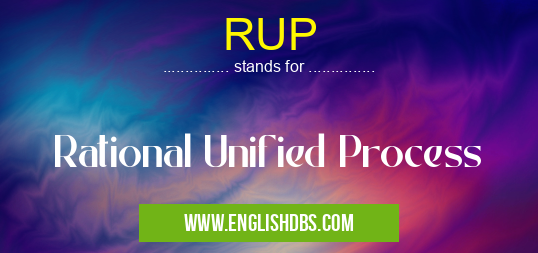What does RUP mean in COMPUTING
RUP (Rational Unified Process) is a software development framework that provides a disciplined approach to developing high-quality software. It is designed to be iterative and incremental, with a focus on early and continuous testing. RUP is based on the Unified Modeling Language (UML) and incorporates best practices from various software development methodologies.

RUP meaning in Computing in Computing
RUP mostly used in an acronym Computing in Category Computing that means Rational Unified Process
Shorthand: RUP,
Full Form: Rational Unified Process
For more information of "Rational Unified Process", see the section below.
Key Concepts
- Use Case Driven: RUP focuses on identifying and defining use cases that describe the functionality of the software from the user's perspective.
- Iterative and Incremental: RUP follows an iterative and incremental approach, where the software is developed in small increments, with each increment building on the previous one.
- Model-Based: RUP uses models to represent the software system at different levels of abstraction. These models are used for design, analysis, and testing.
- Architecture Centric: RUP emphasizes the importance of software architecture and provides guidelines for designing and evaluating architectures.
- Risk-Driven: RUP identifies and manages risks throughout the development process, ensuring that potential issues are addressed early on.
Benefits
- Improved Quality: RUP's structured approach helps ensure the development of high-quality software that meets user requirements.
- Reduced Time-to-Market: The iterative and incremental approach allows for early feedback and reduces the overall development time.
- Enhanced Collaboration: RUP promotes collaboration between different stakeholders, including developers, testers, and business analysts.
- Flexibility: RUP can be tailored to specific project needs and can be used in a variety of development environments.
Essential Questions and Answers on Rational Unified Process in "COMPUTING»COMPUTING"
What is the Rational Unified Process (RUP)?
The Rational Unified Process (RUP) is a software development framework that provides a structured approach to software development. RUP is based on the Unified Modeling Language (UML) and is designed to help teams develop high-quality software products.
What are the benefits of using RUP?
RUP provides a number of benefits, including:
- Improved communication and collaboration among team members
- Reduced risk of project failure
- Increased software quality
- Faster time to market
- Improved customer satisfaction
What are the key components of RUP?
The key components of RUP include:
- The process model: The process model defines the overall structure of the software development process.
- The lifecycle model: The lifecycle model defines the phases and activities that make up the software development process.
- The artifacts: The artifacts are the documents and other deliverables that are produced during the software development process.
- The roles: The roles define the responsibilities of the different team members involved in the software development process.
How do I use RUP?
To use RUP, you will need to:
- Define your project goals and objectives.
- Select the appropriate RUP process model for your project.
- Tailor the RUP process model to meet your specific needs.
- Implement the RUP process model in your organization.
- Monitor and control your project progress.
What are some resources for learning more about RUP?
There are a number of resources available to help you learn more about RUP, including:
- The Rational Unified Process website: http://www.ibm.com/developerworks/rational/products/rup/
- The Rational Unified Process book: http://www.amazon.com/Rational-Unified-Process-Addison-Wesley/dp/0201704426
- The Rational Unified Process training courses: http://www.ibm.com/developerworks/rational/training/
Final Words: RUP is a widely adopted software development framework that provides a comprehensive and disciplined approach to developing high-quality software. Its focus on use cases, iterative development, and model-based design makes it an effective choice for complex and critical software systems.
